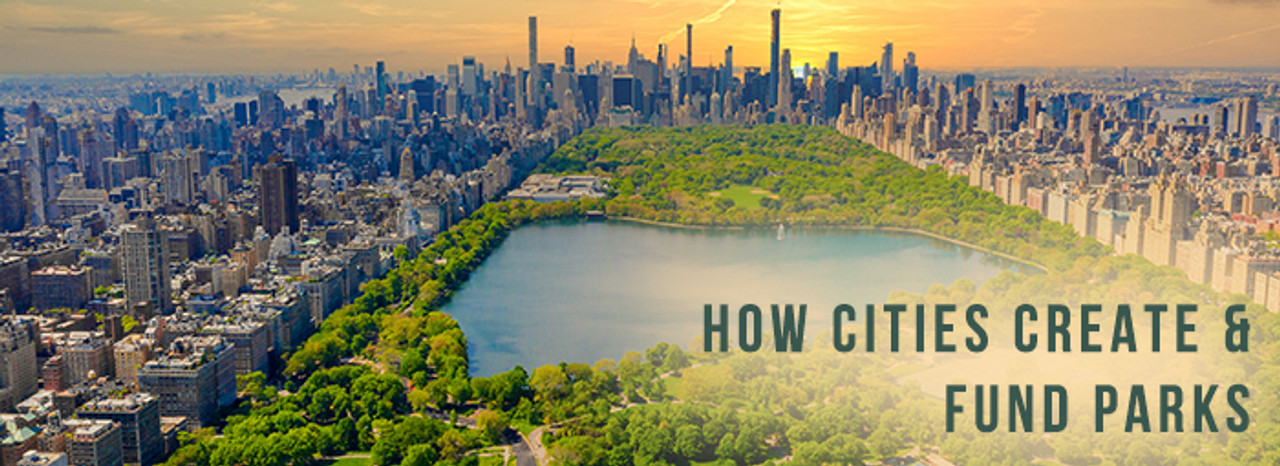Since the 17th century, the US has dedicated some of its resources to ensuring access to public parks to provide a green space for recreation and socialization. Industrialization and urbanization has taken over the modern world, making city parks more important than ever, because of how parks benefit communities in many ways, from health and well being, to arts and culture. City parks are an overlooked suburban gem in the midst of busy urban life, but the reality is that city parks are an important part of cities and are a valuable investment.
Ever wonder how a city does plan and fund a park? Like most things in modern life, it’s done with a great deal of planning and coordinating moving parts over a long span of time. In any case, sanitation and waste disposal are an important part of the construction and operation of cities and city parks.
Trash Cans Unlimited is the best choice for all your waste disposal needs, whether it’s park trash cans and outdoor furnishings, or waste baskets and soap dispensers for homes and offices. We don’t only know trash cans though, we’ll take you through the process of the planning and funding, and the design and construction of city parks.
How do cities plan and design parks?
Private parks are a different matter entirely, but generally speaking, the process of creating and funding a city park is overseen by a city’s parks and recreation department. Money is allocated from a budget or other fundraising opportunities through legislation that approves it. Because parks are held in public trust, they have to be approved by the governing body.
As far as design goes, an architect or team of architects creates the designs, usually in tandem with engineers that can ensure that the design is feasible within the budget and environmental requirements, and meets the community’s needs.
Citizens, politicians, and other members of the community may work together to determine the facilities and design of the park to meet the needs of the community, whether it’s for children’s enrichment with playgrounds, hiking and bike trails to encourage physical activity, or more focused around interaction with nature.
How do cities fund parks?
Cities fund parks in a number of ways, but the most common are taxes, grants, bonds, trusts, dedications, and donations. For a more comprehensive understanding of the cost and funding of parks, it helps to see examples from other sources. Local governments and public organizations will frequently make reports, data, statistics, white papers, and other resources in regards to their funding and funding allocations available to the public.
For example: Parks: Funding Methods, Management Structures, and Costs A Report for the City of Minneapolis April 1, 2008, from The Public Trust For Land (TPL), a nonprofit organization based in San Francisco, CA. The TPL is a great resource for all kinds of information about parks all over the United States.
Taxes
Because parks are public spaces, they are often paid for by the taxes of the citizens who would use the park. Cities create budgets for the taxes to be spent on, all available for public review and comment. Elected officials and the occasional public referendum determine budgets and how the funds in those budgets will be allocated for park construction.
Grants
Grants are funds that are given to individuals or organizations to contribute to the enrichment or development of a particular cause or agenda. Grants can come from taxes, capital, fundraising contributions, or donations from benefactors or corporations. Grants can also be pulled from other governmental or private organizations.
Bonds
Bonds, generally speaking, are loans that the government takes from citizens to pay off at a fixed rate. Bond financing is a common method of paying for parks in a mutually beneficial way for investors and stakeholders.
Trusts
Many cities often have trusts of funds that are invested and distributed for projects like parks. When managed well, trusts can be a source of income in perpetuity.
Dedication or “Fee-in-Lieu-Of”
Parks can be joint ventures between developers and local governments as well, and when this is the case, a government might require the developer to dedicate a portion of the land to the municipality for parks and recreation purposes while the developer builds some other kind of property nearby or on the premises. Fee-in-lieu of systems can be used to provide park facilities, recreational facilities, or privately reserve a part of the park for recreational use.
Parks do not inherently generate revenue, but they can be used to partially or fully fund themselves using different methods and means (like community programs for instance).
Donations
Donations can come from a variety of sources for a number of reasons — nonprofit organizations, businesses, or individuals. Many contributions can be for enrichment or philanthropic reasons, and come in the form of monetary donations, equipment donations, land donations, and even contributions in the form of services or labor. Parks can bring communities together in a number of ways from conception and creation to maintenance and recreational use.
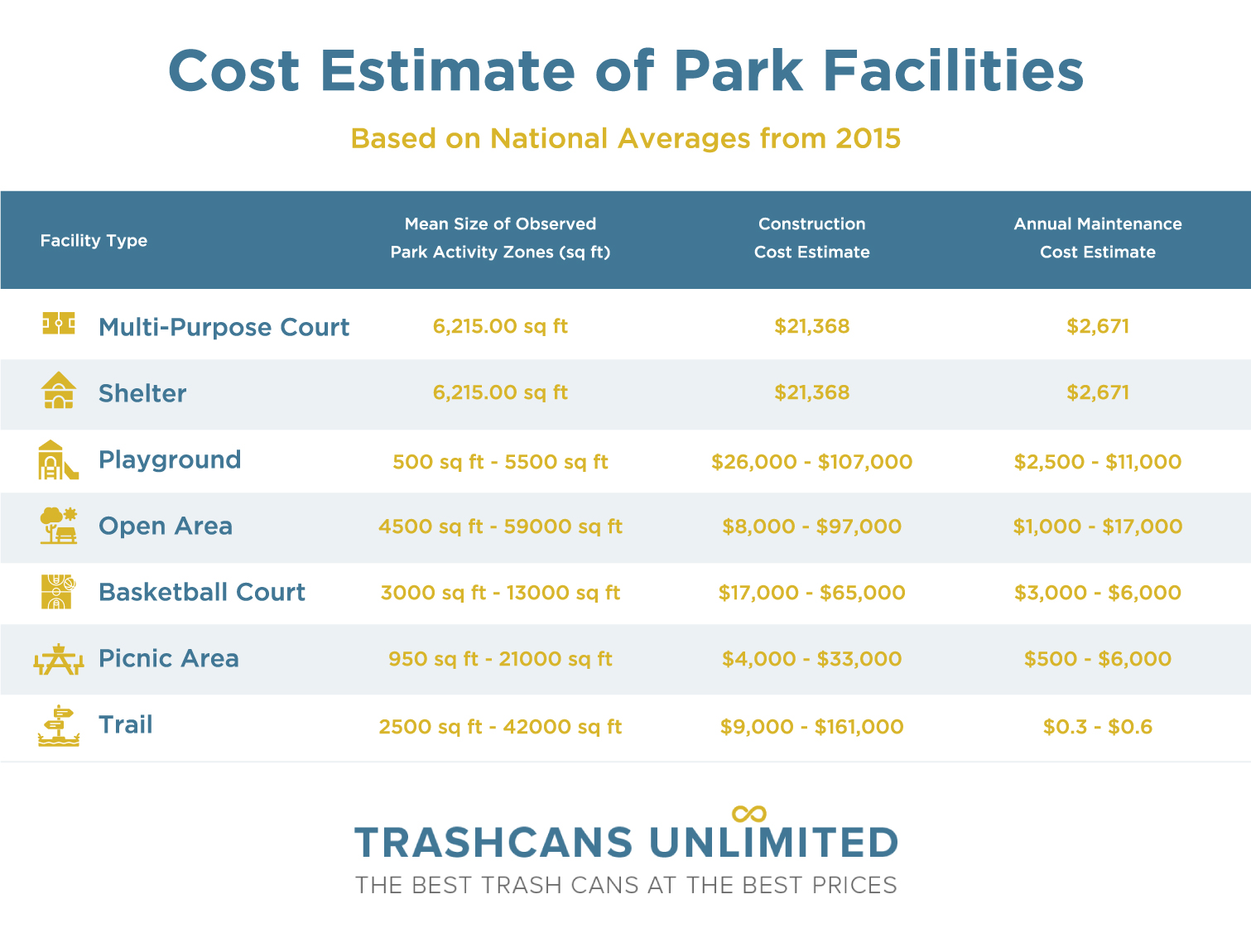
How much do parks cost?
There are a lot of factors that contribute to the cost to design, build, and maintain city parks. Just like every city, every city park is different — different ecosystems, sizes, dimensions, climates, visitors, facilities, and activities. In addition, the cost of materials and labor change over time and vary amongst locations.
In 2007 the national average to construct a city park was $33,897.00, or $4,326,079 per acre. Parks can range from $1,000,000 for the entire development, or even as little as $500,000 per acre.
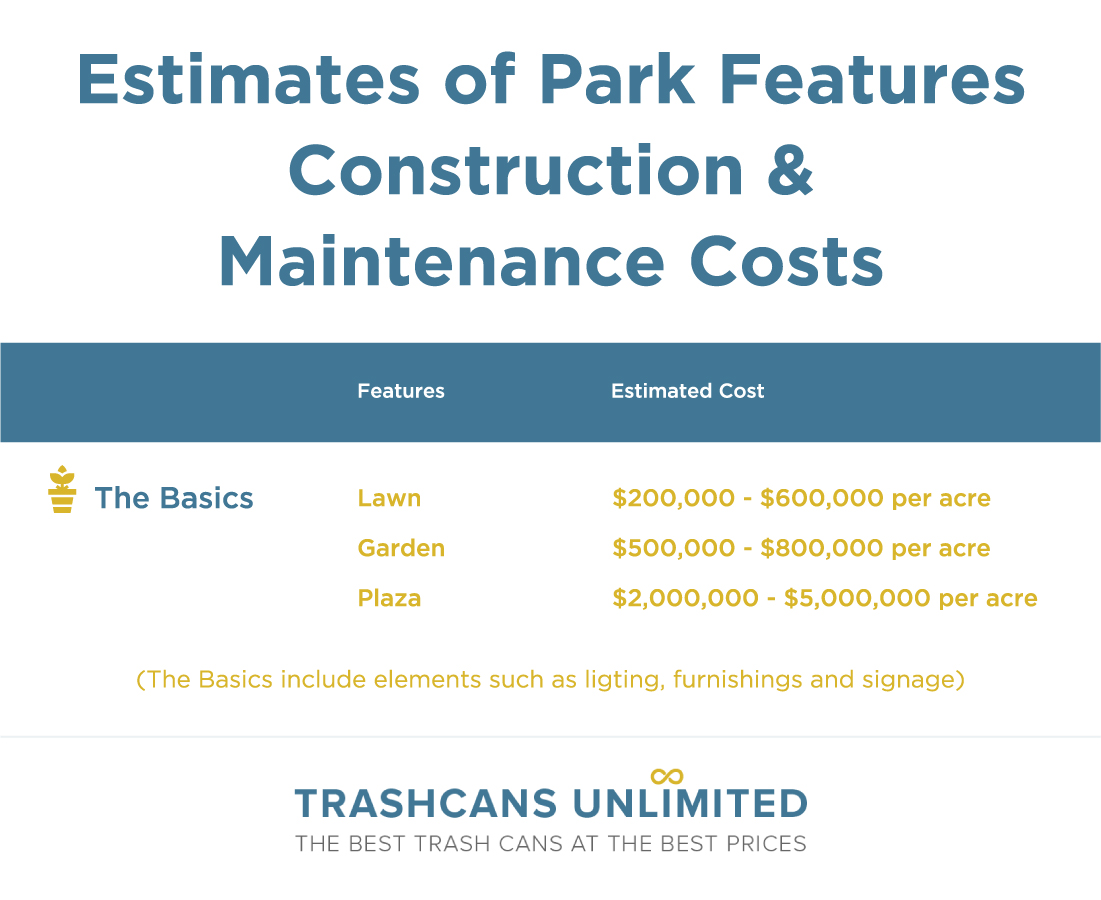
Design
Determining where the park will be, how big it will be, what it will look like, and how it will be used are the basics of designing a park. The American Planning Association has a helpful resource to provide an idea of the design and planning for city parks: Standards for Outdoor Recreational Areas.
Parks can serve a number of purposes, and not just for recreation and exercise. They are used for environmental conservation and preserving plants, animals, and even entire ecosystems. This also serves as an educational opportunity for patrons to learn about their own environment and interact with it in a way that is not detrimental to it. These kinds of parks will have a different layout and facilities to optimize it for both the ecosystem and visitors.
Parks can also revitalize a city and stimulate the economy by creating a hub for business and culture. They are accessible public spaces for artists, performers, crafters, builders, designers, musicians, retailers, and producers of all kinds to conduct their business. Many parks are the location of choice to host local markets for people to buy, sell, or trade wares and services.
After determining what the desired purposes are for the park and therefore determining the design, the next stage is construction.
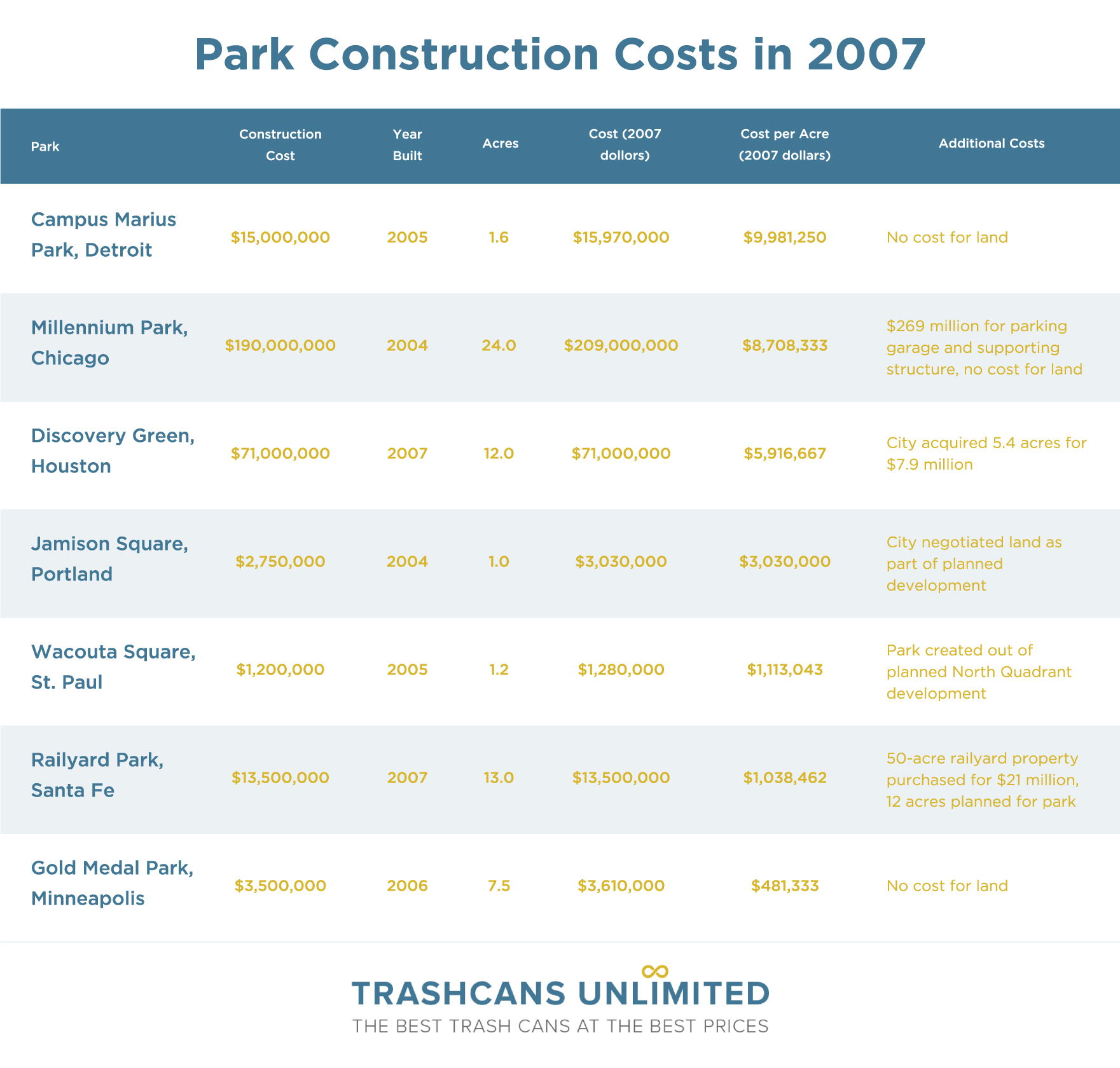
Construction & Furnishings
The first portion of city park costs is the construction of it. Parks often need excavation, landscaping, and facility installation in order to make them safe and comfortable for use. Additionally, there are features like parking, benches, paving, signage, lighting, water, and other construction when building the park itself. This can end up costing millions of dollars, which is usually par for the course for large scale public projects.
You can find a more detailed breakdown of the estimated average cost of park facilities across multiple cities and states from 2015 from one of our sources, NC State University, including, cost per footage, hours of use, number of users of the facilities, and more.
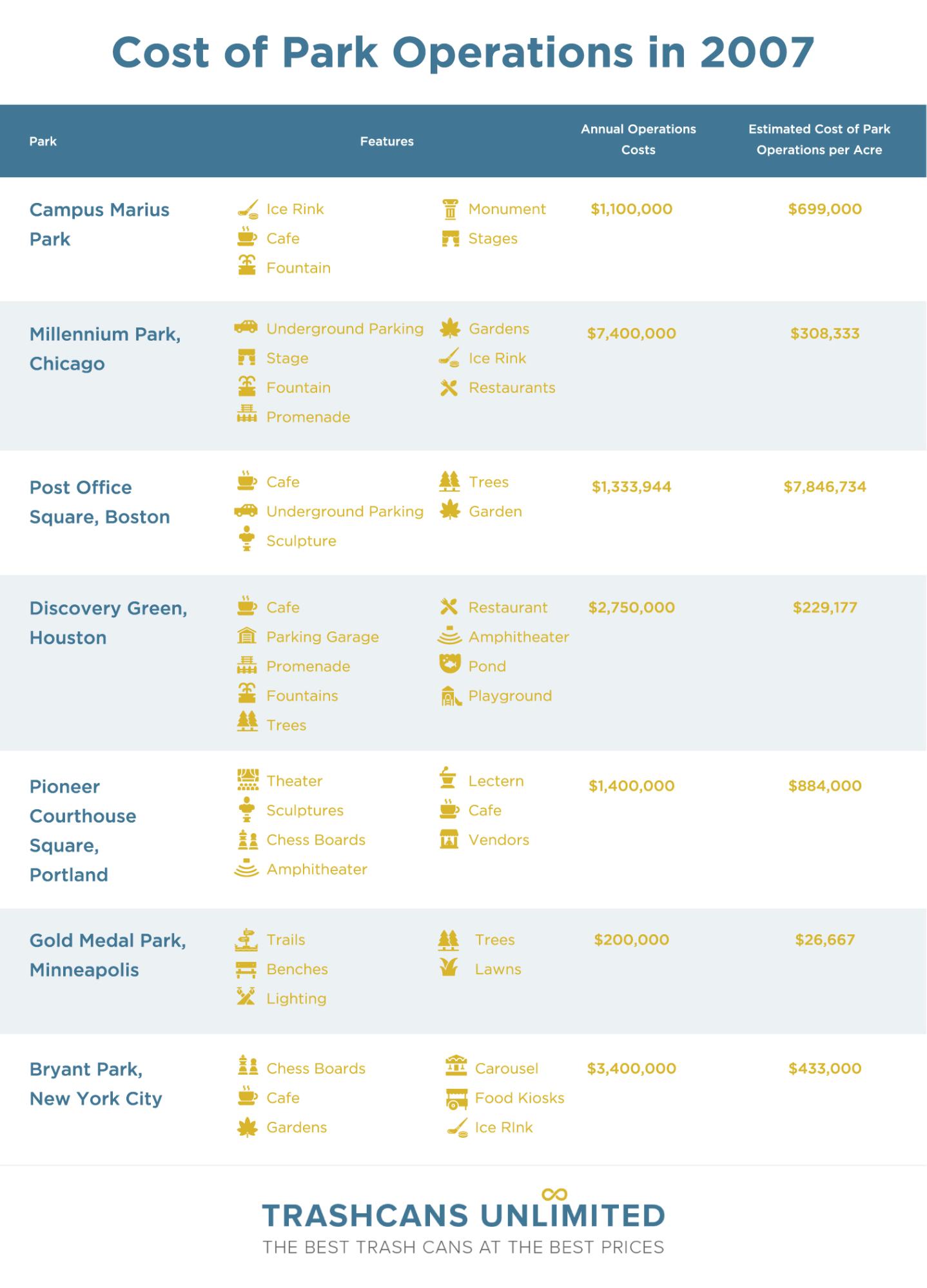
Operation & Maintenance
The biggest portion of park costs is, you guessed it, maintenance. Maintenance is ongoing and never really stops, so you need a consistent inflow of funds to keep the park in good shape. Here are some examples of maintenance costs:
- Trash cans - The park has to stay clean if the city wants people to use it. Trashcans Unlimited provides parks with the tools they need to maintain sanitation efforts in this regard.
- Litter and graffiti removal
- Weeding and leaf removal
- Landscaping
- Pest control
- Snow and ice removal
- Power washing and facility sanitizing
- Facility operations- Lifeguards for pools, electricians for lights, plumbers for bathrooms
The number of hours spent doing these activities depends on the specific park itself. A helpful example of the cost to operate and maintain parks is New York City’s Annual Report on Park Maintenance Fiscal Year 2018. This is a detailed report that breaks down locations, activities, hours, costs, and even more in regards to park operations and maintenance.
Parks create jobs in every stage of the process, from design and construction to maintenance and recreation. City parks require regular services and maintenance to operate, which means more jobs for more people across multiple industries — construction, custodial, landscaping, performer, retailers, and more. A lot goes into the development and management of a park, and that park gives back by creating an accessible public space that can serve a variety of purposes.
Trash Cans Unlimited - Your Litter Control Experts
For any park, construction project, or industry for that matter, you’re going to need trash cans. Trashcans Unlimited provides park benches, trash cans, and many other furnishings, including ones for furry friends. Check out our inventory of outdoor trash cans and site furnishings, or chat with one of our customer service representatives for more information.

